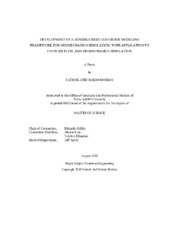| dc.description.abstract | With the recent development of unconventional reservoirs, attention has been geared towards the integration of the geomechanical models with traditional flow simulation. A case in point is quantifying rock-fluid interactions in hydraulic fracturing operations. Although much effort has gone into the creation and advancement of commercial simulation software for coupled flow and geomechanics, it is still in its infancy. The models are considerably oversimplified and poorly representative of the problem’s complex nature. Throughout history, several contributions have been made into the development of efficient model-order reduction (MOR) techniques for “flow only” simulations. Yet – to date – contributions to the mechanical models in coupled simulations have been minimal.
This study tackles this challenging aspect, by proposing a novel model reduction adaptive workflow, especially for the mechanics simulators, that (1) can be coupled with any simulator that can export mass, stiffness, and load matrices; (2) can achieve 2 orders of magnitude in computational time reduction; and (3) do not add more complexity to the solution.
In the first part of this research, several – widely used – reduction techniques for structural mechanics were implemented based on the construction of the dynamic condensation matrix. Single-step reduction methods were first executed; in particular, Guyan DOFs based reduction techniques. Following that, two-step methods were implemented; where corrections were made to the results obtained from the former. Finally, iterative (three-step) reduction methods were applied; handling the problem of master DOFs selection through consistent updates of the dynamic condensation matrix until convergence is achieved. To that end, two schemes are presented; based on the convergence of the dynamic condensation matrix, as well as, the eigenvalues of the reduced-order model.
In the second part of this research, we provide a rigorous framework for testing the completeness, efficiency, and convergence for all the presented reduction techniques. Regarding the completeness of the reduced models, two main criteria were investigated; namely, modal assurance criterion (MAC) and singular value decomposition (SVD). For efficiency testing, percent error (PE) of natural frequencies and the correlation coefficient for modal vector (CCFMV) values were considered. Finally, the efficiency of the convergent criterion was demonstrated through the errors associated with the column vectors of the condensation matrix. Several numerical examples are presented to show the efficiency of the presented framework, particularly for coupled simulations.
Based on the adopted framework, we managed to reduce the scale of the finite element models to less than 9% of the full model with error as low as 1%. In terms of computational speed and runtime, we achieved substantial speedups; up to 20X. Given the proposed workflow, large-scale complex simulations – similar to those associated with hydraulic fracturing – could be more feasible and less costly. This, ultimately, would give allowance for incorporating the complex physics pertinent to unconventional reservoirs and motivate the advent of their development at no additional cost. | en |


